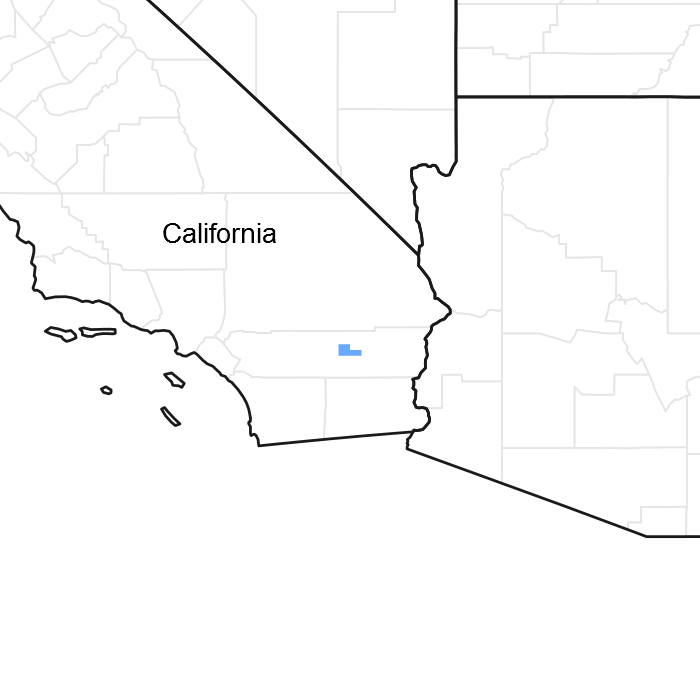

Natural Resources
Conservation Service
Ecological site R030XB218CA
Moderately Deep To Very Deep Loamy Fan Remnants
Last updated: 10/21/2024
Accessed: 12/21/2025
General information
Provisional. A provisional ecological site description has undergone quality control and quality assurance review. It contains a working state and transition model and enough information to identify the ecological site.

Figure 1. Mapped extent
Areas shown in blue indicate the maximum mapped extent of this ecological site. Other ecological sites likely occur within the highlighted areas. It is also possible for this ecological site to occur outside of highlighted areas if detailed soil survey has not been completed or recently updated.
MLRA notes
Major Land Resource Area (MLRA): 030X–Mojave Basin and Range
MLRA Description:
Major Land Resource Area (MLRA) 30, Mojave Desert, is found in southern California, southern Nevada, the extreme southwest corner of Utah and northwestern Arizona within the Basin and Range Province of the Intermontane Plateaus. The climate of the area is hot (primarily hyperthermic and thermic; however at higher elevations, generally above 5000 feet, mesic, cryic and frigid) and dry (aridic). Elevations range from below sea level to over 12,000 feet in the higher mountain areas found within the MLRA. Due to the extreme elevational range found within this MLRA, Land Resource Units (LRUs) were designated to group the MLRA into similar land units.
LRU Description:
This LRU (designated by ’XB’) is found across the eastern half of California, much of the mid-elevations of Nevada, the southernmost portions of western Utah, and the mid-elevations of northwestern Arizona. Elevations range from 1800 to 5000 feet and precipitation ranges from 4 to 9 inches per year, but is generally between 5-6 inches. This LRU is characterized primarily by the summer precipitation it receives, ranging from 18 – 35% but averages 25%. Summer precipitation falls between July and September in the form of rain, and winter precipitation falls starting in November and ends between February and March, also mostly in the form of rain; however it does receive between 0 and 3 inches of snow, with an average of 1 inch. The soil temperature regime is thermic and the soil moisture regime is typic-aridic. Vegetation includes creosote bush, burrobush, Nevada jointfir, ratany, Mojave yucca, Joshua tree, chollas, cactus, big galleta grass and several other warm season grasses. At the upper portions of the LRU, plant production and diversity are greater and blackbrush is a common dominant shrub.
Classification relationships
Larrea tridentata Shrubland Alliance (Sawyer et al. 2009).
Ecological site concept
This site is associated with the group concept R030XB174CA
This ecological site occurs on thermic fan aprons or fan aprons over fan remnants at elevations of 2230 to 4000 feet, with slopes of 2 to 8 percent. The soils associated with this ecological site are moderately deep to deep to a pan, and/or have a thick argillic (clay-enriched) horizon, or are deep sands that receive additional moisture from very rare sheet flooding.
Production Reference Value (RV) is 400 pounds per acre and ranges from 270 to 720 pounds per acre. The site is dominated by burrobush (Ambrosia dumosa), Hall’s shrubby spurge (Tetracoccus hallii) and creosote bush (Larrea tridentata). Increased moisture availability at shallow depths increases the competitive ability of burrobush. This ecological site occurs at the southern edge of the Mojave Desert (the Mojave Desert-Sonoran Desert or MLRA30-31 boundary). Thus, it represents a transition from a warm desert where winter precipitation is dominant, to a hot desert where summer precipitation is much more significant. Ancient pediment landforms surround the site, and soils with considerable horizon development, and a thick argillic horizon, petrocalic pan (calcium carbonate) and/or duripan (silicate) are typical. The area is likely a relictual stronghold of a formerly more continuous distribution of Hall’s shrubby spurge, when rainfall was more abundant.
Data ranges in the physiographic data, climate data, water features, and soil data sections of this Ecological Site Description are based on major components only (15 percent of map unit or greater).
Associated sites
| R030XB005NV |
Arid Active Alluvial Fans R030XB005NV is found on adjacent fan aprons. Burrobush (Ambrosia dumosa) and creosote bush (Larrea tridentata) dominate. |
|---|---|
| R030XB220CA |
Very Shallow Duripan Fan Remnants R030XB220CA occurs on adjacent fan remnants. Burrobush (Ambrosia dumosa) and lotebush (Ziziphus obtusifolia) are dominant species. |
| R030XB221CA |
Loamy Fan Remnants And Pediments R030XB221CA is found on adjacent moderately deep fan remnants. Blackbrush (Coleogyne ramosissima), burrobush (Ambrosia dumosa) and Hall's shrubby spurge (Tetracoccus hallii) are dominant species. |
| R030XB225CA |
Warm Sloping Pediments R030XB225 is found on pediments adjacent to this site. Burrobush (Ambrosia dumosa) and Hall's shrubby spurge (Tetracoccus hallii) are dominant species. |
| R030XY188CA |
Slightly Alkaline, Rarely To Occasionally Flooded Ephemeral Stream R030XY188CA is found on adjacent rarely flooded drainageways and inset fans. Hall's shrubby spurge (Tetracoccus hallii) and creosote bush (Larrea tridentata) dominate. |
Similar sites
| R030XB225CA |
Warm Sloping Pediments R030XB225CA is found on pediments with very shallow to shallow soils. Burrobush (Ambrosia dumosa) and Hall's shrubby spurge (Tetracoccus hallii) dominate, and creosote bush (Larrea tridentata) is a minor species. Production is lower and plant diversity is higher. |
|---|---|
| R030XB221CA |
Loamy Fan Remnants And Pediments R030XB221CA occurs on fan remnants with moderately deep soils to a duripan. Blackbrush (Coleogyne ramosissima) is a co-dominant species with burrobush (Ambrosia dumosa) and Hall's shrubby spurge (Tetracoccus hallii). |
| R030XY188CA |
Slightly Alkaline, Rarely To Occasionally Flooded Ephemeral Stream R030XY188CA occurs on rarely flooded landforms associated with ephemeral drainageways. Hall's shrubby spurge (Tetracoccus hallii) and creosote bush (Larrea tridentata) dominate the site. |
| R030XB005NV |
Arid Active Alluvial Fans R030XB005NV is found on similar landforms and soils, but Hall's shrubby spurge (Tetracoccus hallii) is absent. |
Table 1. Dominant plant species
| Tree |
Not specified |
|---|---|
| Shrub |
(1) Ambrosia dumosa |
| Herbaceous |
Not specified |
Click on box and path labels to scroll to the respective text.

